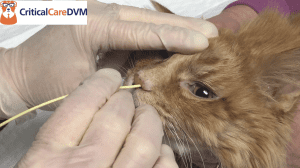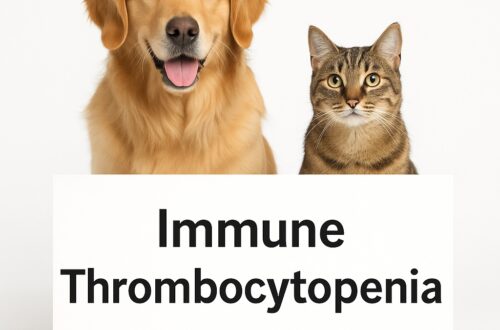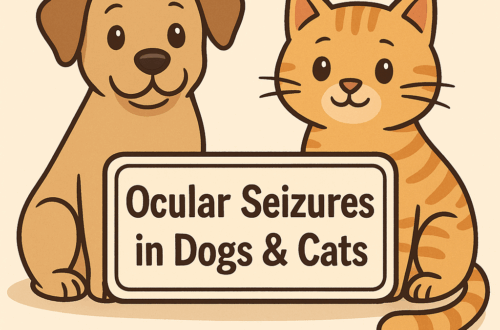Proper nutrition is just as important for our pets as it is for us. Unfortunately, when our cats and dogs become ill, their appetites often decrease or disappear altogether. Despite this worsening of appetite, the need for adequate nutrition doesn’t decrease. Indeed, it often increases! The use of temporary supplement feeding tubes is a minimally invasive means of ensuring our sick pets receive the nutrition support they need. This week I share information about the temporary feeding tubes commonly used in our furry feline and canine companions. Happy reading!

When do you use a feeding tube?
Our pets need nutrition to stay strong and live healthy lives. Nutrition is very important during times of illness, as the body needs proteins, carbohydrates, and fat to heal. Using the gastrointestinal tract to deliver nutrients – compared to giving them through an intravenous infusion – is superior. Veterinarians have a mantra regarding the fact:
If the gut works, use it!
A veterinarian’s decision to recommend placing a feeding tube is based on a complete nutrition assessment and patient’s overall medical status. Feeding tubes are primarily used as a means to provide nutrition, but they can also be used to administer medications.
What types of tubes can be used?
There are different types of tubes that can be used. Factors that help veterinarians determine which tube to select include patient size, patient disposition, underlying disease(s), and anticipated duration of use.
Common feeding tubes used in cats and dogs are:
Nasoesophageal tube (NE tube) – These tubes have small lumens and can be gently passed through a nasal passage until the end of the tube ends in the distal esophagus (food pipe). Usually only a topical anesthetic (e.g.: nose drops) is needed to place these tubes, but occasionally a brief period of light sedation is needed. Liquid diets are fed through NE tubes. They are only used during hospitalization and are left in place for less than five days.

Nasogastric tube (NG tube) – These tubes are very similar to NG tubes. Instead of the tube terminating in the last part of the esophagus, the end of the tube terminates in the stomach.
Esophagostomy tube (E tube) – These tubes are larger in diameter, and are placed directly in the esophagus via a minor surgical procedure performed during a brief period of anesthesia. Canned food mixed with extra water are mixed into a gruel consistency so they can be fed through the E tube. Esophagostomy tubes are used in patients who need nutritional support for more than five days. They should not be used in patients with disorders of the esophagus. The tubes can be readily used at home by pet owners to both feed their pets and administer medications.

Gastrostomy tube (G tube) – These tubes are larger in diameter, and require placement either via surgery or endoscopy. They are appropriate for patients who have diseases affecting the esophagus (e.g. megaesophagus), but should not be used in patients with primary stomach diseases and/or diseases that cause vomiting. Gastrostomy tubes can be placed using endoscopic guidance, giving rise to a percutaneous endoscopic gastrostomy (PEG) tube. These tubes can be readily used at home by pet owners to both feed their pets and administer medications. Gastrostomy tube must remain in place for two weeks before removal or replacement.
Jejunostomy tube (J tube) – These tubes are smaller in diameter than E tubes and G tubes, and they end in the a part of the small intestines called the jejunum. These tubes are often placed surgically, but occasionally are placed through the nose similar to an NE/NG tubes and then terminate in the jejunum with endoscopic guidance. This type of tube is called a nasojejunostomy tube or NJ tube. Similarly, a J tube can also be inserted through a G tube, giving rise to the aptly named gastrojejunostomy tube or GJ tube. All types of jejunostomy tubes are not commonly used but are appropriate considerations for patients undergoing as wide variety of gastrointestinal, pancreatic, and biliary surgeries. These tubes are usually only used during hospitalization, and must remain in place for 10-14 days.
Using E & G tubes at home…
Temperature of formula:
- Food administered via a feeding tube should be at room temperature (or slightly warmer) to avoid vomiting.
- Prior to feeding, draw up the required volume of formula into a syringe, and let stand for a while at room temperature or in warm water. Do not microwave.
- Test the temperature by placing a drop of the warmed feeding formula on the inside of your wrist. It should feel lukewarm.
Rate of administration:
- Always feed the formula through a feeding tube slowly (15-45 minutes depending on tube type) to decrease the likelihood of vomiting.
- The minimum amount of time between feedings is 2 to 3 hours.
Medications:
- If any liquid medications are to be given, they may be administered through the feeding tube (unless otherwise directed by a veterinarian).
- If your pet requires any medication(s) in tablet form, you may be able to crush the tablet into a fine powder and mix it with water so it may be administered through the feeding tube.
- Some medications will clog the tube if administered in this way. Ask your pet’s veterinarian before administering medications via feeding tubes.
Aspirating the tube:
- Before administrating each feeding, aspirate the tube by drawing back on an empty syringe. Depending on the volume aspirated, your pet’s medical team may recommend skipping that feeding.
Flushing the tube:
- To avoid clogging the tube, owners should flush the feeding tube with a small volume (e.g. 3-5 milliliters) of warm water after administering anything through the tube (including medications and feeding formula).
Offering food:
- Even though your pet is receiving nutrition through a feeding tube, the ultimate goal is to support the pet until they can eat enough food. Therefore, it is a good idea to continue to feed your pet regular meals to entice their to eat on their own! In some cases, this may be contraindicated, so speak to your pet’s veterinarian first.
Troubleshooting at home…
- Vomiting: If your pet vomits while the feeding tube is in place, skip the next feeding. At the feeding, be sure the formula is adequately warmed and fed very slowly. Watch your pet carefully for vomiting. If your pet vomits again, call your veterinarian immediately. If your pet vomits and the tube subsequently protrudes from their mouth, discontinue all administration of formula and medication(s) and call your veterinarian because the tube is no longer in its proper place. It needs to be removed and possibly replaced. If your pet vomits the tube up and bites off the end, discontinue all administrations and call your veterinarian.
- Tube Displacement: If your pet pulls out the tube, please call your veterinarian immediately. This may be an emergency!
- Clogging of theTube: In spite of adequate flushing, feeding tubes may become clogged. If you discover your pet’s feeding tube is clogged, try the following:
- First try to vigorously aspirate the feeding tube by drawing back on a syringe several times.
- If this technique is unsuccessful, try to force warm water through the tube by exerting pressure on the syringe. Be sure to hold the connection between the syringe and the tube very tightly to avoid spraying you both!
- If this technique is unsuccessful, place a small volume (e.g.: 3-5 milliliters) of Coca-Cola® into the tube for 10-15 minutes. Then attempt to feed through the feeding tube.
Pet owners should consult a veterinarian as soon as possible should any of the following occur:
- Tube insertion site is excessively irritated, reddened, painful, and/or swollen
- Foul-smelling material is found at the insertion site
- Your pet coughs and/or develops breathing problems
- The feeding tube cracks or rips
The take-away message about feeding tubes…
Sick pets require adequate nutritional support to maximize the likelihood of a positive outcome. The use of temporary feeding tubes can help all of us achieve that goal. Feeding tubes are generally well-tolerated by cats and dogs, and use of them can truly be life-saving.
To find a board-certified veterinary internal medicine specialist, please visit the American College of Veterinary Internal Medicine.
To find a board-certified veterinary emergency and critical care specialist, please visit the American College of Veterinary Emergency and Critical Care.
To find a board-certified veterinary surgeon, please visit the American College of Veterinary Surgeons.
To find a board-certified veterinary nutrition specialist, please visit the American College of Veterinary Nutrition.
Wishing you wet-nosed kisses,
CriticalCareDVM




